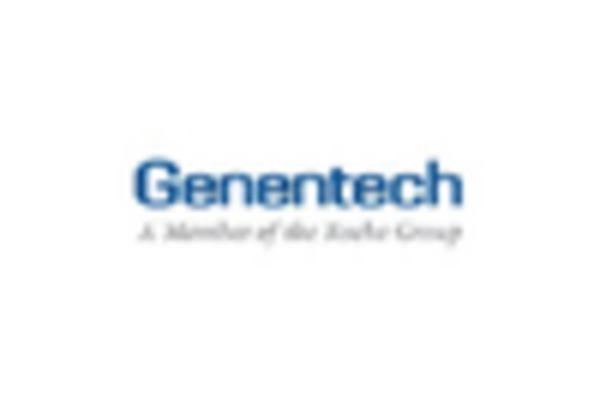Increase in Incidence Rates
The eye melanoma market is experiencing a notable increase in incidence rates, which appears to be a significant driver for growth. Recent data indicates that the annual incidence of uveal melanoma in the US is approximately 5.1 cases per million people. This rising trend may be attributed to factors such as increased exposure to ultraviolet (UV) radiation and genetic predispositions. As more individuals are diagnosed, the demand for effective treatment options and diagnostic tools in the eye melanoma market is likely to escalate. This surge in cases necessitates advancements in therapeutic strategies, thereby propelling the market forward. Furthermore, the growing population of older adults, who are at a higher risk for developing melanoma, could further contribute to the increasing incidence rates, thereby influencing the overall dynamics of the eye melanoma market.
Rising Healthcare Expenditure
Rising healthcare expenditure in the US is another pivotal driver influencing the eye melanoma market. With healthcare spending projected to reach approximately $6 trillion by 2027, there is an increasing allocation of resources towards cancer treatment and research. This financial commitment is likely to enhance the availability of advanced diagnostic tools and treatment options for eye melanoma. Moreover, as patients gain better access to healthcare services, early detection and timely intervention become more feasible, potentially improving survival rates. The eye melanoma market stands to benefit from this trend, as increased funding may facilitate clinical trials and the introduction of novel therapies. Consequently, the overall growth trajectory of the eye melanoma market could be positively impacted by the rising healthcare expenditure.
Technological Innovations in Treatment
Technological innovations in treatment modalities are playing a crucial role in shaping the eye melanoma market. The introduction of targeted therapies and immunotherapies has revolutionized the treatment landscape, offering new hope to patients. For instance, the use of proton beam therapy has shown promising results in minimizing damage to surrounding healthy tissues while effectively targeting tumors. Additionally, advancements in laser treatments and photodynamic therapy are enhancing treatment efficacy. The eye melanoma market is likely to benefit from these innovations. They not only improve patient outcomes but also attract investment from pharmaceutical companies. As the market continues to evolve, the integration of cutting-edge technologies may lead to the development of more personalized treatment plans, further driving growth in the eye melanoma market.
Growing Patient Advocacy and Support Groups
The emergence of patient advocacy and support groups is significantly influencing the eye melanoma market. These organizations play a vital role in raising awareness about eye melanoma, educating patients, and promoting early detection. By providing resources and support, they empower patients to seek timely medical attention, which may lead to earlier diagnoses and improved treatment outcomes. Furthermore, these groups often collaborate with healthcare professionals and researchers to advocate for funding and research initiatives. As awareness increases, the demand for effective treatments and diagnostic tools in the eye melanoma market is likely to rise. This grassroots movement not only fosters a supportive community but also drives the market by encouraging innovation and investment in research and development.
Regulatory Support for Innovative Therapies
Regulatory support for innovative therapies is emerging as a key driver in the eye melanoma market. The US Food and Drug Administration (FDA) has been increasingly proactive in expediting the approval process for novel treatments, particularly those that demonstrate significant therapeutic potential. This regulatory environment encourages pharmaceutical companies to invest in research and development, leading to the introduction of groundbreaking therapies. The eye melanoma market is likely to benefit from this trend, as faster approvals can facilitate quicker access to life-saving treatments for patients. Additionally, the FDA's emphasis on personalized medicine may further enhance the development of targeted therapies, aligning with the evolving needs of patients. As regulatory support continues to strengthen, the eye melanoma market may witness accelerated growth and innovation.

















Leave a Comment